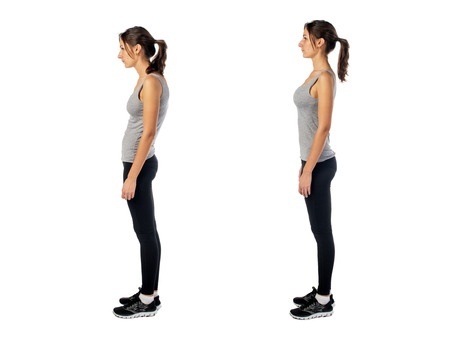
To be effective as a speaker, you need to fill your performance space. Here's how to use body language and presence to own a stage.
When you watch and listen to a great speaker, do you go home and thrill to the slides you've seen? Or do you still experience the power of that person's presence?
I'll bet you're fully aware—and maybe a little in awe—of how they owned the stage. And when you stop and think about it, wasn't a lot of the effect of their performance visual?
Successful presentations depend on powerful nonverbal communications. Get my free resource "The Body Language Rules: 12 Ways to Be a More Powerful Speaker" with easy-to-learn techniques for connecting with and influencing listeners.
The Physical Dimension of Stage Performance
The theaters in the most vibrant theatrical eras—the ancient Greek amphitheaters and the Elizabethan “thrust” stage—were designed for the audience’s response. In Athens, the playing area was circular, and the seats rose steeply so everyone could see and hear clearly. The thrust stage of Shakespeare's time juts out into the house, so the audience is on three sides. The physical relationship of actor and audience is as vital as anything spoken by the players.
Consider, on the other hand, the modern auditorium where you'll present or listen at your next conference. It's huge and rectangular and far away from most spectators, with row after row of seats in front of it, like the trenches that had to be stormed individually in World War I. Could any design be more effective in limiting the intimacy between performer and theatergoer?
 Owning Your Body to Own the Stage
Owning Your Body to Own the Stage
And yet, your job in the hotel ballroom or convention stage where you speak is to fill that stage. That is to say, you have to own it. And the only way to do that is first to acquire ownership of your body. As voice coach Patsy Rodenburg reminds us, “We know long before someone speaks whether we will listen to him or her. We know as soon as an actor walks onto the stage whether he will engage us.” 1
The first step is this process of demanding that listeners attend to what you’re about to say, is knowing how to display confidence. Stand straight, open your chest area, and move deliberately and energetically. How important is this? A recent study of presentations to raise venture capital found that the best gauge for predicting success wasn’t the person’s credentials or even their pitch. It was how strongly they displayed three specific traits: confidence, comfort, and passionate enthusiasm.2
To gain practical knowledge of how to use the physical dimension for stage presence—to make it happen for you on stage—you need to understand the mind-body connection. Your emotional state especially is tied to what you’re doing and showing physically.
 Feeling and Showing Works in Both Directions
Feeling and Showing Works in Both Directions
We seem to understand this in terms of one direction, but not the other. We know, that is, that the way we feel is often expressed physically. When we’re sad our face shows it, and we may even cry; when we’re happy we smile, etc.
But it happens in the opposite direction as well, so that the way we hold ourselves and move creates an emotional response inside us. You can easily test this yourself: Stand tall with your shoulders in place, your feel slightly apart, and your chest out. Don’t you feel confident and ready? Now, allow your shoulders to fall and your chest to cave inward; bend slightly at the spine, and place your hands one palm over the other in your crotch area. That posture is virtually an advertisement for powerlessness!
As I say to clients, “How you stand affects your standing with your audience.” What’s happening here (and whenever you assume body positions and postures), is that your mind and body interpret the physical and the emotional as a single connection. After all, they have a lifetime of experience in interpreting how you hold yourself and move based on what you’re feeling. Understanding this is priceless information concerning how you come across to others.

The Body As a Source of Your Power
Rather than worrying about how you occupy a stage (as many speakers do), accept that body language is a tool for making what you say more evident. When you amplify your point with an appropriate gesture, the idea behind what you're saying—as well as the strength with which you say it—actually becomes visible.
As TED Talks star Amy Cuddy puts it:
The way you carry yourself is a source of personal power—the kind of power that is the key to presence. It’s the key that allows you to unlock yourself—your abilities, your creativity, your courage, and even your generosity. It doesn’t give you skills or talents you don’t have; it helps you to share the ones you do have. It doesn’t make you smarter or better informed; it makes you more resilient and open. It doesn’t change who you are; it allows you to be who you are. 3
Now a key point: If what your body is doing makes you feel a certain way, why wouldn’t it bring about a similar response in audiences? Your physical stance, posture, gestures, and movement cause an emotional response in listeners, as well as any information you're imparting.
So begin thinking of your physicality as part of stage presence. Practice three techniques in particular:
- Stand and move with confidence. Improve your posture if you need to, and be aware of whether you’re sitting straight or slouching. Develop the habit of maintaining eye contact even if you’re thinking of what to say next. Some people find this a real challenge, as their next point often seems to be on the ceiling or the floor!
- Fill the stage. That really means, don’t be afraid to use all parts of the performance space. It may be a few square feet at the end of a conference table in a meeting room, or the wide stage of a convention hall. Audience members’ brains are biased toward processing visual information, and you need to be tapping into that resource.
- Bring up the energy level when you start to speak. Actually, do it before you speak. As soon as listeners observe that you are an energetic person with something exciting to say, they will be excited to hear it!
Accomplish these three things and everyone will get a clear sense that you’re present and the owner of this stage. And so will you.
[1] Patsy Rodenburg, The Actor Speaks (New York: St. Martin’s, 2000), 15.
[2] L. Balachandra, “Keep Calm and Pitch On: Balancing and Moderating Affect in the Entrepreneur’s Pitch,” 2015. Manuscript submitted for publication. Quoted in Amy Cuddy, Presence (Boston: Little, Brown, 2015), 19.
[3] Cuddy, 198.
You should follow me on Twitter here.



